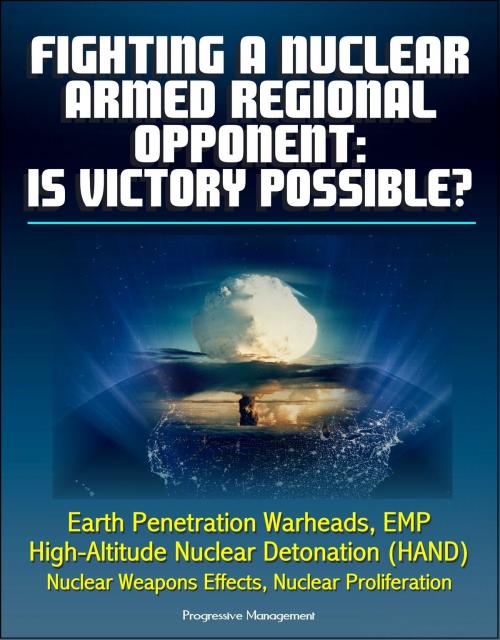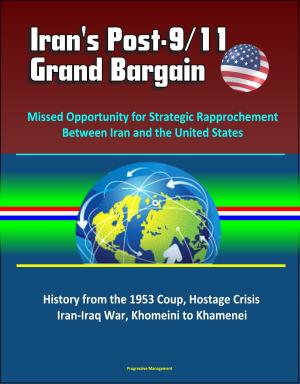Fighting a Nuclear-Armed Regional Opponent: Is Victory Possible? Earth Penetration Warheads, EMP, High-Altitude Nuclear Detonation (HAND), Nuclear Weapons Effects, Nuclear Proliferation
Nonfiction, Social & Cultural Studies, Political Science, Politics, Arms Control, History, Military, Nuclear Warfare| Author: | Progressive Management | ISBN: | 9781301179718 |
| Publisher: | Progressive Management | Publication: | June 6, 2013 |
| Imprint: | Smashwords Edition | Language: | English |
| Author: | Progressive Management |
| ISBN: | 9781301179718 |
| Publisher: | Progressive Management |
| Publication: | June 6, 2013 |
| Imprint: | Smashwords Edition |
| Language: | English |
In order to sustain the current international system organized around American-led alliances, the United States may need to be able to confront challenges posed by revisionist powers armed with nuclear weapons. Immature or transitional nuclear powers are likely to pose especially pressing problems for US strategy and military planning over the coming decades. In light of this probability, the United States should develop the capability both to confront and, at least in a limited sense, defeat such powers while also preventing or deterring them from employing nuclear weapons for decisive effect. Such a balancing act will require a sophisticated set of capabilities and equally sophisticated planning, posturing, and action. This study will examine several different possible responses, each with a correlative set of capability requirements. The first option is to maintain the status quo with its brittle binary responses to nuclear threats: inaction or nuclear retaliation. The second option would invest in capabilities that allow the US to defeat an adversary witling to use its nascent nuclear arsenal. The last option is an extensive program intended to permit the US to conduct operations across the military spectrum in the face of significant nuclear use by an opponent.
The bottom line is quite simple: the United States should have military and technological options to deal with emerging nuclear powers. However, investing in meaningful response options would require the US political leadership to acknowledge that the current status quo strategy - with its focus on preparing for strictly conventional regional contingencies - is dangerously inadequate. This may be especially true in dealing with emerging nuclear states, such as the Islamic Republic of Iran, that have a strongly revisionist geo-strategic agenda. On the other hand, if the United States decides against making the investment to adapt to these emerging nuclear powers, it calls into question the central rationale for continuing a massive and sustained investment in high technology conventional capabilities since few will wish to fight the United States on its own terms. In a world of nuclear-armed adversaries, forces optimized to fight only conventionally-armed regional powers would seem to have little utility.
The Range of Regional Nuclear Threats * Nascent or Tier One Capabilities: Limited Retaliatory Capability * Militarily Operational or Tier Two Capabilities: Multi-Salvo Capability * Mature Tier Three Capabilities: Assured Retaliatory Capability * The Shield/Sword Challenge * US National Military Response Options * The Status Quo, Option A * Moderate Adaptation Strategy, Option B * Aggressive Adaptation Strategy, Option C * Overview * I. THEMES FROM THE HISTORY OF NUCLEAR PROLIFERATION * II. THE STRATEGIC CHALLENGE OF EMERGING NUCLEAR POWERS * III. ALTERNATIVE NATIONAL SECURITY RESPONSES * Option A * Doctrine and Concepts of Operation * Option B * Doctrine and Concepts of Operation * Option C * Doctrine and Concepts of Operation * IV. Preparing for Nuclear Operations: Cold War Lessons Learned * V. RESPONDING TO A REGIONAL NUCLEAR CHALLENGE: THE STATUS QUO, OPTION A * Enhanced Counterforce Investments * All Weather Precision Guided Munitions * Persistent Attack Munitions * All Weather Precision and Persistent Surveillance and Targeting * Enhanced Active Defense Investments * The National Security Space (NSS) Architecture * On EMP and High Altitude Nuclear Detonation (HAND) * Enhanced R&D and Training * Enhanced Expeditionary Capability * An Overview * VI. "DEFEATING" A NUCLEAR-ARMED REGIONAL POWER: A MODERATE ADAPTATION STRATEGY, OPTION B * Requirements for Option B * The Dynamic Regional Nuclear Threat * Counter-Nuclear Campaign Requirements * Persistent Reconnaissance-Strike * A New Generation of Earth Penetration Warheads * Resurrecting Joint Counter-Nuclear Campaign Training * Active Defenses * More Robust C4ISR
In order to sustain the current international system organized around American-led alliances, the United States may need to be able to confront challenges posed by revisionist powers armed with nuclear weapons. Immature or transitional nuclear powers are likely to pose especially pressing problems for US strategy and military planning over the coming decades. In light of this probability, the United States should develop the capability both to confront and, at least in a limited sense, defeat such powers while also preventing or deterring them from employing nuclear weapons for decisive effect. Such a balancing act will require a sophisticated set of capabilities and equally sophisticated planning, posturing, and action. This study will examine several different possible responses, each with a correlative set of capability requirements. The first option is to maintain the status quo with its brittle binary responses to nuclear threats: inaction or nuclear retaliation. The second option would invest in capabilities that allow the US to defeat an adversary witling to use its nascent nuclear arsenal. The last option is an extensive program intended to permit the US to conduct operations across the military spectrum in the face of significant nuclear use by an opponent.
The bottom line is quite simple: the United States should have military and technological options to deal with emerging nuclear powers. However, investing in meaningful response options would require the US political leadership to acknowledge that the current status quo strategy - with its focus on preparing for strictly conventional regional contingencies - is dangerously inadequate. This may be especially true in dealing with emerging nuclear states, such as the Islamic Republic of Iran, that have a strongly revisionist geo-strategic agenda. On the other hand, if the United States decides against making the investment to adapt to these emerging nuclear powers, it calls into question the central rationale for continuing a massive and sustained investment in high technology conventional capabilities since few will wish to fight the United States on its own terms. In a world of nuclear-armed adversaries, forces optimized to fight only conventionally-armed regional powers would seem to have little utility.
The Range of Regional Nuclear Threats * Nascent or Tier One Capabilities: Limited Retaliatory Capability * Militarily Operational or Tier Two Capabilities: Multi-Salvo Capability * Mature Tier Three Capabilities: Assured Retaliatory Capability * The Shield/Sword Challenge * US National Military Response Options * The Status Quo, Option A * Moderate Adaptation Strategy, Option B * Aggressive Adaptation Strategy, Option C * Overview * I. THEMES FROM THE HISTORY OF NUCLEAR PROLIFERATION * II. THE STRATEGIC CHALLENGE OF EMERGING NUCLEAR POWERS * III. ALTERNATIVE NATIONAL SECURITY RESPONSES * Option A * Doctrine and Concepts of Operation * Option B * Doctrine and Concepts of Operation * Option C * Doctrine and Concepts of Operation * IV. Preparing for Nuclear Operations: Cold War Lessons Learned * V. RESPONDING TO A REGIONAL NUCLEAR CHALLENGE: THE STATUS QUO, OPTION A * Enhanced Counterforce Investments * All Weather Precision Guided Munitions * Persistent Attack Munitions * All Weather Precision and Persistent Surveillance and Targeting * Enhanced Active Defense Investments * The National Security Space (NSS) Architecture * On EMP and High Altitude Nuclear Detonation (HAND) * Enhanced R&D and Training * Enhanced Expeditionary Capability * An Overview * VI. "DEFEATING" A NUCLEAR-ARMED REGIONAL POWER: A MODERATE ADAPTATION STRATEGY, OPTION B * Requirements for Option B * The Dynamic Regional Nuclear Threat * Counter-Nuclear Campaign Requirements * Persistent Reconnaissance-Strike * A New Generation of Earth Penetration Warheads * Resurrecting Joint Counter-Nuclear Campaign Training * Active Defenses * More Robust C4ISR















